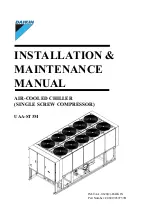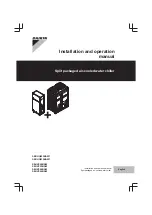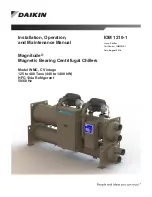
Manufacturer reserves the right to discontinue, or change at any time, specifications or designs without notice and without incurring obligations.
PC 903
Catalog No. 533-00047
Printed in U.S.A.
Form 30RA-2T
Pg 1
1-03
Replaces: 30RA-1T
Book 2
Tab
5c
Controls, Start-Up, Operation,
Service, and Troubleshooting
SAFETY CONSIDERATIONS
Installing, starting up, and servicing this equipment can be
hazardous due to system pressures, electrical components, and
equipment location (roof, elevated structures, mechanical
rooms, etc.). Only trained, qualified installers and service
mechanics should install, start up, and service this equipment.
When working on this equipment, observe precautions in
the literature, and on tags, stickers, and labels attached to the
equipment, and any other safety precautions that apply. Follow
all safety codes. Wear safety glasses and work gloves. Use
care in handling, rigging, and setting this equipment, and in
handling all electrical components.
Electrical shock can cause personal injury and death. Shut
off all power to this equipment during installation and
service. There may be more than one disconnect switch.
Tag all disconnect locations to alert others not to restore
power until work is completed.
DO NOT VENT refrigerant relief valves within a building.
Outlet from relief valves must be vented outdoors in
accordance with the latest edition of ANSI/ASHRAE
(American National Standards Institute/American Society
of Heating, Refrigeration and Air Conditioning Engineers)
15 (Safety Code for Mechanical Refrigeration). The
accumulation of refrigerant in an enclosed space can
displace oxygen and cause asphyxiation. Provide adequate
ventilation in enclosed or low overhead areas. Inhalation of
high concentrations of vapor is harmful and may cause
heart irregularities, unconsciousness or death. Misuse can
be fatal. Vapor is heavier than air and reduces the amount
of oxygen available for breathing. Product causes eye and
skin irritation. Decomposition products are hazardous.
DO NOT attempt to unbraze factory joints when servicing
this equipment. Compressor oil is flammable and there is
no way to detect how much oil may be in any of the
refrigerant lines. Cut lines with a tubing cutter as required
when performing service. Use a pan to catch any oil that
may come out of the lines and as a gage for how much oil
to add to system. DO NOT re-use compressor oil.
This unit uses a microprocessor-based electronic control
system. Do not use jumpers or other tools to short out
components, or to bypass or otherwise depart from recom-
mended procedures. Any short-to-ground of the control
board or accompanying wiring may destroy the electronic
modules or electrical components.
To prevent potential damage to heat exchanger, always run
fluid through heat exchanger when adding or removing
refrigerant charge. Use appropriate brine solutions in cooler
fluid loop to prevent the freezing of brazed plate heat
exchanger, optional hydronic section and/or interconnecting
piping when the equipment is exposed to temperatures
below 32 F (0 °C). Proof of flow switch and strainer are
factory installed on all models. Do NOT remove power
from this chiller during winter shutdown periods without
taking precaution to remove all water from heat exchanger
and optional hydronic system. Failure to properly protect
the system from freezing may constitute abuse and may
void warranty.
Compressors and optional hydronic system pumps require
specific rotation. Test condenser fan(s) first to ensure
proper phasing. Swap any two incoming power leads to
correct condenser fan rotation before starting any other
motors.
Refrigerant charge must be removed slowly to prevent loss
of compressor oil that could result in compressor failure.
30RA010-055
AquaSnap® Air-Cooled Chillers
with
Comfort
Link™ Controls
50/60 Hz
Summary of Contents for AquaSnap 30RA010
Page 6: ...6 Fig 1 Typical Control Box for 30RA010 030 022 030 Shown ...
Page 7: ...7 Fig 2 Typical Control Box for 30RA032 055 042 055 Shown ...
Page 8: ...8 Fig 3 Wiring Schematic 30RA010 018 30RA010 018 AQUA SNAP ...
Page 10: ...10 Fig 4 Wiring Schematic 30RA022 030 30RA022 030 AQUA SNAP ...
Page 11: ...11 Fig 4 Wiring Schematic 30RA022 030 cont AQUA SNAP LOW VOLTAGE CONTROL SCHEMATIC 022 030 ...
Page 12: ...12 Fig 5 Wiring Schematic 30RA032 040 30RA032 040 AQUA SNAP ...
Page 13: ...13 Fig 5 Wiring Schematic 30RA032 040 cont AQUA SNAP LOW VOLTAGE CONTROL SCHEMATIC 032 040 ...
Page 14: ...14 Fig 6 Wiring Schematic 30RA042 055 30RA042 055 AQUA SNAP ...
Page 15: ...15 Fig 6 Wiring Schematic 30RA042 055 cont AQUA SNAP LOW VOLTAGE CONTROL SCHEMATIC 042 055 ...


































